A plum job

This week: Visitors; Data and bases; A Plum job; It’s the Romans again…; Plums in the orchard; So what to do?
Visitors
A drop in the temperature this week has been welcome. Once again, just not what you expect at this time of year here though. With temperatures in the mid 20’s centigrade, it has been very pleasant working outside.
We even had some rain too. Not a lot, but enough to allow me to hoe over the citrus orchard with some degree of ease. Several thunderstorms passed the island. We really could have done with a good downpour.
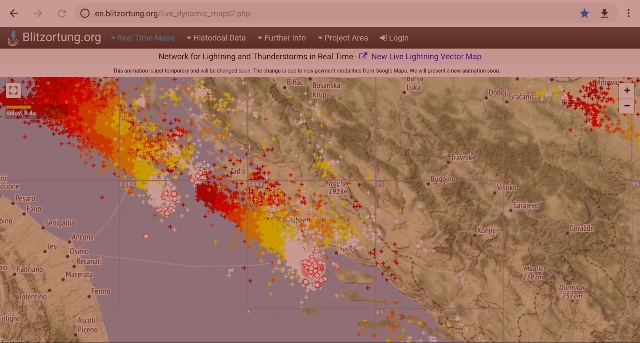
However the direct, high sun soon dried the soils again.
I’ve been over to Split as well. Some retired colleagues have been on a motorcycle tour of Europe and came over on the ferry from Ancona, ready to start wending their way north-eastwards back home.

Data and bases
I’ve had a sore head more than once this week.

At the start of the week, I was discussing with retired colleagues and someone who is restoring a former police vehicle, what the livery for the period should be.
I have a set of the door badges from almost every UK police force, mounted on card. When they are on the wall, they take up quite a lot of space. I also came across one of the crests which were applied as part of the livery to the motorcycles I was riding in the 1980’s.
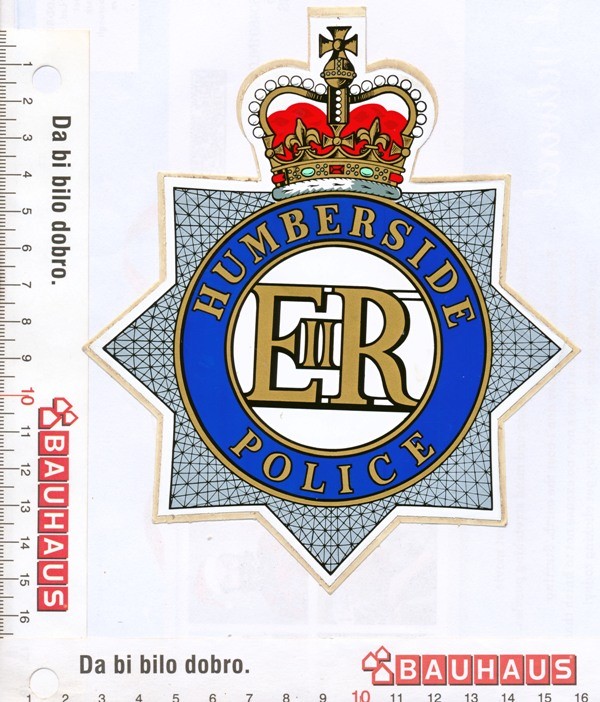
It seems that I have perhaps the only complete set, but they are a snapshot in time. Collected for a specific purpose in the 1980’s, I have never tried to keep up to date with the name and livery changes in the UK. I wish I had done now.

Names change over time, some “Constabularies” have become “police”.

Some forces have been merged into others and some have changed their names.

But what did occur to me was that there is no record anywhere of all these changes. So as I already have a head start with a good number of these crests, I thought I would write a database to record the details.
That is not as easy as it sounds. I have used ACCESS®, one of the Microsoft Office™ suite of programmes previously, but my legal copy is old now, and the cost of upgrading is prohibitive for the amount of use I will make of it.
Also, to make the information available to others would mean them having to buy Office as well. So I used an open source alternative, LibreOffice instead.
I do embrace the concept of “Open Source” software and donate as appropriate, for the software I use.
People study database design at university and then get highly paid jobs as software writers. Although I have completed a single ACCESS course, the rest of my knowledge is self taught. There are some extremely good books, also some extremely dull and boring books on the art of writing a relational database.
But knowing the principles, and armed with several guides, I spent a couple of wet days designing the way the database will work. Books do tend to assume a level of knowledge, even when they are marked as “For beginners“.
One of the problems with “Open Source” is that paperwork does not always keep abreast of the software development.
I wanted to put a ‘Save’ button onto my data entry form. The .pdf handbook is very clear, as is the online wiki help page: Drag and drop a button from the status line, onto the page.
But no matter what I did, nothing would drag or drop. It took a lot of reading and then eventually watching a YouTube video for me to discover that in newer iterations of the software, drag and drop has been superseded by “click and draw”.
The online help and books have not kept pace with the software developments.
However at the end of the week, I have the task almost complete. I just need to include a couple of features and I’ll be ready to start adding the data.

I feel it is really important to record this information, while people still remember it and the information is out there. There will come a time in the not too distant future, when it will all have been lost in the mists of time.
A Plum job
Plums and similar drupes seem to grow well on my impoverished soils. There are three mature trees and I have planted four more.
I wrote six weeks ago about a bough of my Myrobalan plum having broken during a storm and now resting on the dry stone wall.
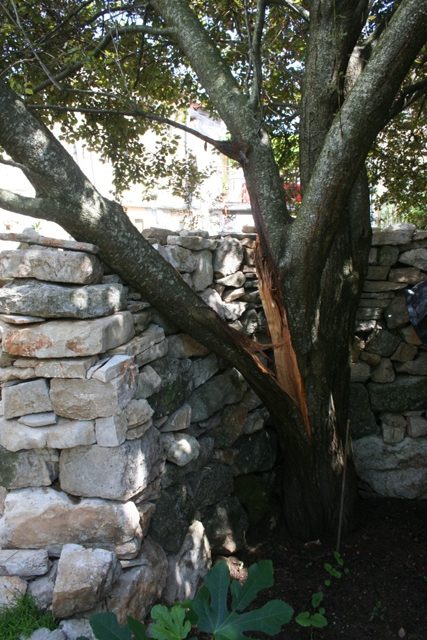
This week the plums have started to fall off, so I decided that I would begin the task of dismembering the broken bough and begin picking the plums.
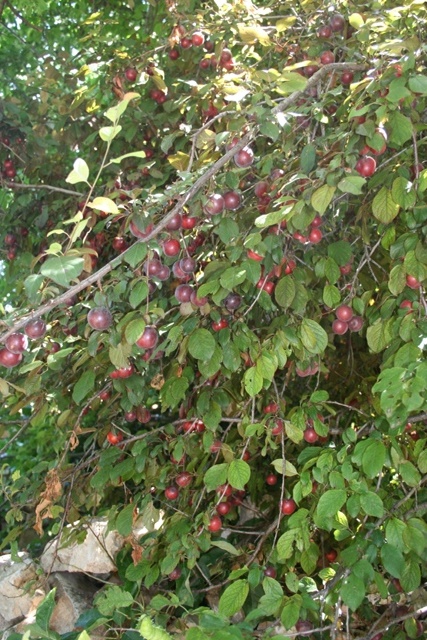
A lot of the branches were at or just above head height, which made cutting them easy.
This is still a substantial tree, so big it is visible in Google Earth. With it’s bronze foliage it is also a striking tree, which provides a lot of shade in summer and protects the orchard with its own micro-climate in winter.

It’s sad to have to remove this bough, but as it has split down the main trunk, there is no way to join it back up.
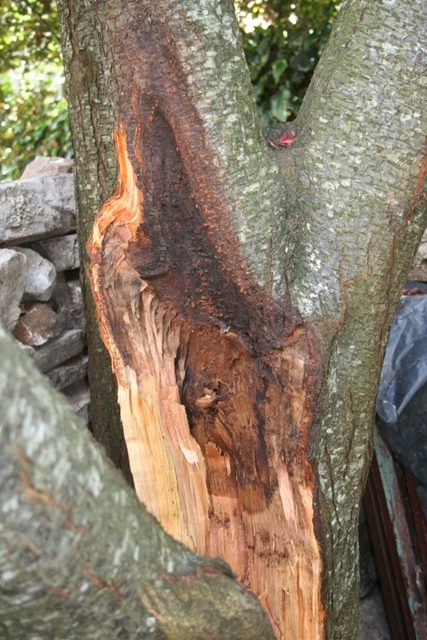
Before dismembering the largest pieces, I cut the smaller branches with secateurs and the larger ones with a bushman saw.
The plums came off the stalks without difficulty and I gathered them in a bucket. With such a large quantity I took some round to neighbours and then tried to decide what to do with those remaining.
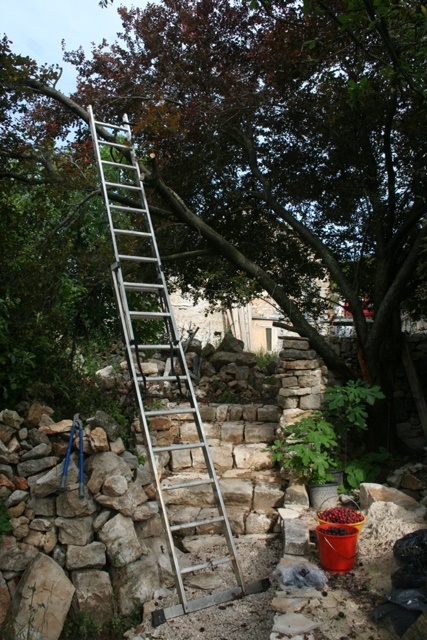
I will need to get the chain saw out this week though, to cut and remove the largest limbs.

I will put all the small branches through the shredding machine to make compost, whilst everything large enough to burn will be used for heating this winter, so nothing will be wasted.
It’s the Romans again…
Plums are in the botanic family Prunus, which also encompasses Sloes, Greengage, Apricots and Damsons.
Plums were domesticated in China more than 2,000 years ago and have figured in written documents since 479 BCE. These fruits were the plums Confucius praised in his writings and they are the ancestors of today’s Asian plums.
Apricots (Prunus armeniaca) are mentioned in Chinese scripts from the Emperor Yu (2,205 – 2,198 BCE).
The plums we eat and enjoy today are descended from several sources which have been crossed and hybridised to get the variety, flavour and sweetness we desire.
Wild plums flourished throughout both the Old and New Worlds suggesting that they are some of the earliest fruiting trees, which were part of Gondwana, separating as the super-continent broke up and drifted apart.
These early plum trees were then transported along the great trading routes, to arrive in the Mediterranean. The Greek Philosopher and writer Pliny describes plums in his ancient Greek writings.
But like many edible plants, herbs and fruits, it was the Romans during their great civilising empire, who transported the plum tree throughout Europe. (Origins of Fruit Growing)
Unfortunately the plant historians are unable to definitively agree about the domestic plum’s early history.
For example, the European plum (Prunus domestica) originated in the Caucasus Mountains in an area near the Caspian Sea, while Prunus salicina and Prunus simonii originated in Asia. Plum remains have been found in Neolithic age archaeological sites along with olives, grapes and figs.
Chemical analysis of Neolithic pottery (3,384 – 3,370 BCE) found in what is now Switzerland, provides evidence of the fruit and also of milk being used (Journal of Archaeological Science 2006).
Research by Purdue University into the Origins of Fruit Growing is worth a read, and is one of those rare animals, a University paper that can actually be read and enjoyed.

Some historians believe this plum was brought to Rome around 200 BCE, then was carried north to Europe; other researchers say that the Duke of Anjou carried the modern plum home as he returned from Jerusalem at the close of the Fifth Crusade (1198 to 1204) A.D.
Whichever is true, it was the French enthusiastically embraced the European plum, both fresh and dried as prunes.
Eventually, French immigrants carried plum pits to Quebec, where a traveller recorded plum orchards flourishing as early as 1771. Plums also came to North America with British settlers.
Archaeologists have found fruit stones which are related to Mirabelles in French excavation sites that have been Carbon Dated back to the Bronze Age.
Egyptologist’s excavations have shown that in Egypt, dried prunes were placed in the tombs under the Pyramids. The prune was also widely grown in Syria, where the Crusaders were camped, so perhaps the Duke of Anjou theory is correct.
In France, the Middle Ages and especially during the Renaissance is when plums made it into the spotlight. One particular variety, the “Reine-Claude” (a Greengage), took on the name of the Queen of King François the 1st who adored the fruits.
Plums in the orchard
Given how healthy my trees are, I find it strange that there are not more of them in the village.
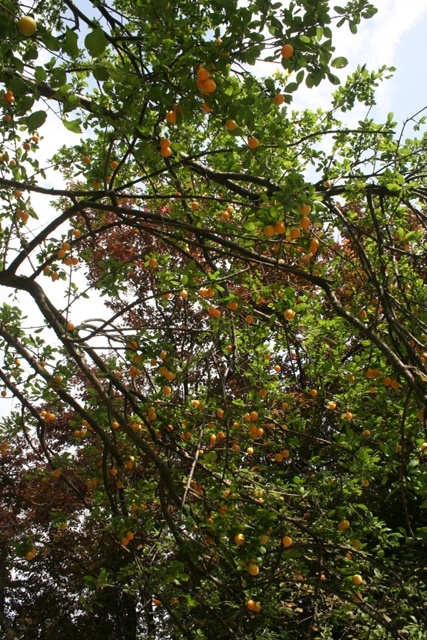
Cvjetko, my builder friends tells me that I have the only trees that he knows of in Dol, but we did discover a similar variety to my yellow Mirabelle at the car mechanics in Vrbanj.
This plum has a much nicer flavour than mine, and rather than being completely yellow, is streaked with red stripes.
I have a type of Victoria Plum in the orchard, which this year is also laden with fruit. It is not a true Victoria, because it ripens to a pale yellow with pale flesh, but has an interesting flavour.

Although I have no idea of the provenance of the tree, I am certain it is a Victoria strain because it shows the usual trait of fruit going mouldy
I have planted two varieties of Apricot which are growing well and in my courtyard is a Greengage, which is yet to fruit, but is slowly growing against a south facing wall.
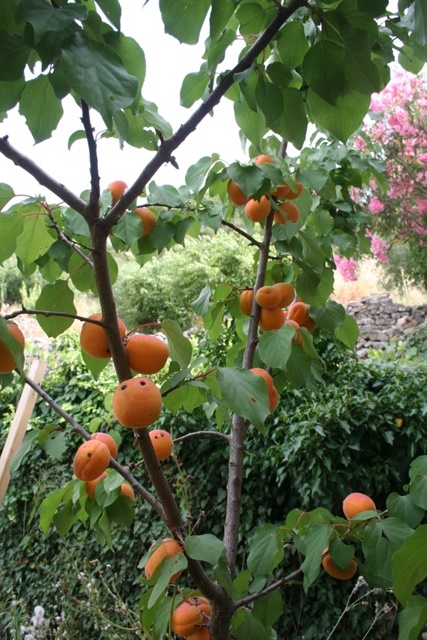
Disappointingly a Shropshire Damson I planted in the courtyard during the past dormant season has not survived the weather extremes we have experienced this spring. But I intend to try again.
Although I have a so called Japanese Plum too, this is Loquat, Eribotrya japonica. It has a plum shape, but multiple stones, and a sweet flavour.
However it too seems to like the growing conditions. There are a lot of these in the village and it is known locally by the name Nispero. This is an unusual tree because the flowers appear in the autumn and winter, develop during the winter and the fruits are ready to pick from March.
I have had a helper with me all week too.
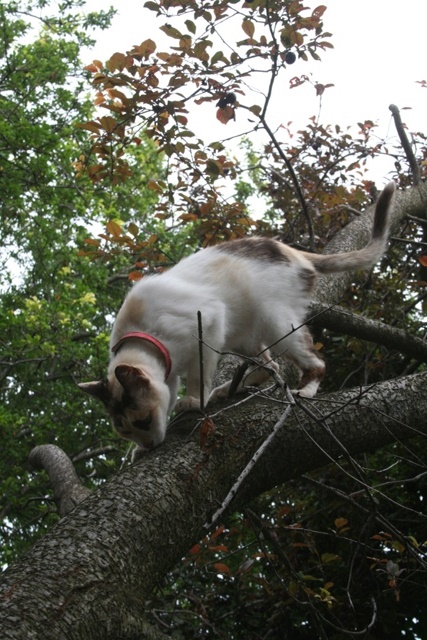
So what to do with all these plums?
A look at the BBC Good Food pages produces no less than 40 different recipes for fresh plums. But this week I tried making plum ice cream with a recipe from the RHS. It was very tasty, but I need to make more (lots more) before I decide how much l like it!
But there is a local recipe I want to try – Knedle od šljiva.
Knedle originates in Germany as the knödel, a potato dough dumpling.
But using plums in cooking has been a Balkan staple for centuries. It was the Austro-Hungarian empire that brought the two together..
With a few more days picking, I’ll also try to make some plum chutney. But I need to go to the supermarket to get some chilli peppers first. NRC
2 Responses
Richard Ellis
Norm,
Do not know if you know of this group, but I find it helpful at times. If you can open it and are interested I can request that you be added (it is a closed group) You may already know some of those who are members.
https://www.facebook.com/groups/508368242584406/
Kristina Wood
Hi Norman,
I ate so many of those plum dumplings as a kid!! I absolutely LOVE them. They are even better the next day, cold from the fridge. A bit of an acquired taste – careful – they grow on you!